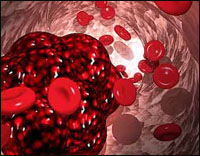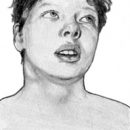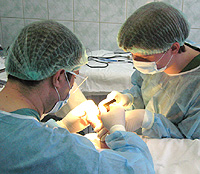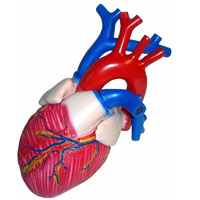Light artery thromboembolism is a deadly complication of deep veins thrombosis and consists in the separation of thrombotic masses and transferring them to pulmonary arteries. If the dimensions of the thrombus are large, then the blockage of the pulmonary artery and the fatal outcome for 10-15 minutes.
Content
Causes of pulmonary artery thromboembolism
The thromboembolism of pulmonary arteries is considered to be one of the most severe and catastrophically occurring acute vascular diseases accompanied by high mortality.
In the overwhelming number of patients with a source of pulmonary artery thromboembolism is thrombosis in the system of the lower hollow vein. Most often, thrombosis is localized in deep veins of the lower extremities and the main pelvis veins. Under the kidney damage, the renal vein thrombosis is possible, distributed to the lower hollow vein.
Tricothetic lesion of hepatic veins. Sometimes thromboembolism can lead thrombosis of the right atrium, which develops against the background of fliccific arrhythmia and dilated cardiomyopathy. The thrombosis of the pulmonary vascular bed is also possible with the endockarization of the three-risk valve and the electrocardiality, complicated by the thrombosis of the right heads of the heart. Extremely rarely pulmonary emboline is complicated by thrombosis in the basin of the upper hollow vein.
The greatest risk of the development of venous thrombosis and, accordingly, patients with oncological diseases, traumatic damage, insufficiency of blood circulation, obesity, forced for various reasons, are subject to a long time to observe the bed regime for various reasons.
Pulmonary artery thromboembolization is a real «Beach» postoperative and postpartum periods.
Risk factors for pulmonary artery thromboembolism:
- Hereditary predisposition (the presence of a direct relative who has thromboembolism)
- Blood coagulation disorders - at the same time increased risk of blood thrombosis
- Heavy operational interventions - a long postoperative period, which increases the risk of developing deep veins thrombosis
- Fractures of bones pelvis and hips (there is also a danger of fatty embolism - blockage by microcapels of intraosny fat)
- Pregnancy and postpartum - In this case, the frequency of the thromboembolism is raised five times, the cause is the presence in the body of a certain hormonal background, which changes blood coagulation, the pressure of the pregnant uterus on large veins, and also after delivery - the presence of an extensive wound, which thrombizes
- Heart disease (for example, a vice of a mitral valve, flickering arrhythmia)
- obesity
- smoking
- Varicose veins - at the same time there is an increased risk of thrombus formation in varicose veins
- The presence of myocardial infarction or stroke in the past
- Malignant tumors
- The use of oral contraceptives containing estrogen
Mechanism for the development of pulmonary thromboembolism
 In the presence of thromboembolism of the branches of the pulmonary arteries, there is a severe breach of the respiratory function and cardiac activity. As a result of the blockage of the lung artery branches, ventilated areas of pulmonary fabric appear through which blood flow does not occur, the so-called «dead space». Next, there is a local blockage of the bronchi in the focus of the lesion with the development of atelectase (falling) of the pulmonary fabric. The flow of oxygen to it through the pulmonary and bronchial arteries, with inhaled air decreases, resulting in a lung infarction. In this case, increasing rightful failure becomes the main cause of death.
In the presence of thromboembolism of the branches of the pulmonary arteries, there is a severe breach of the respiratory function and cardiac activity. As a result of the blockage of the lung artery branches, ventilated areas of pulmonary fabric appear through which blood flow does not occur, the so-called «dead space». Next, there is a local blockage of the bronchi in the focus of the lesion with the development of atelectase (falling) of the pulmonary fabric. The flow of oxygen to it through the pulmonary and bronchial arteries, with inhaled air decreases, resulting in a lung infarction. In this case, increasing rightful failure becomes the main cause of death.
There is dilatation (expansion) of the right ventricular heart. The interventricular partition is filled into the left ventricle and narrows its clearance, and the compression of the right coronary artery helps to reduce the blood flow of the muscular wall of the heart, which can lead to myocardial myocardial infarction. Insufficient filling of the left ventricle causes a reduction in cardiac output. Next comes shock and death of the patient.
With microtromboambolism, a heart attack is a part of the lung with the subsequent development of respiratory and cardiovascular failure. At the same time, the biggest danger is that this condition is developing against the background of relative well-being. With the slightest suspicion of pulmonary artery thromboembolism, the patient must be hospitalized in the surgical department.









